

PanzerKämpfe
This 44-page scenario book was designed to show the range of play possible using the Clash
of Armor game system. The included scenarios are:
| Central Ukraine, Fall 1941 |
|---|
| An ad-hoc Soviet mobile group attempts to block the advance of a German armored
spearhead. Showpiece scenario to demonstrate how the Clash of Armor
command system allows a well-led force to be the equal of a numerically superior enemy. |
| Recommended Table Size | 5 1/2' x 10'
|
|---|
| Approximate Forces | 60 stands (German), 100 stands (Soviet) |
|---|
| Eastern Front German Attack, 1942 |
|---|
| One of three mini-scenarios, each of which shares a common map and provides a short
game suitable for tournament use (playable in 1-2 hours). A reinforced Soviet infantry
battalion must repel a German combined-arms attack.
|
| Recommended Table Size | 3' x 5'
|
|---|
| Approximate Forces | 20 stands (German), 15 stands (Soviet) |
|---|
| Delaying Action in Tunisia, February 1943 |
|---|
| The green American 1st Armored Division in North Africa must defend Sbeitla against elements of the 21st
Panzer Division. Terrain is generally open, with hills in the north; a deep river gully
is the major obstacle.
|
| Recommended Table Size | 8' x 12'
|
|---|
| Approximate Forces | 80 stands apiece |
|---|
| Prochorovka, July 1943 |
|---|
| A portion of the battle which historically is perhaps the greatest tank battle of all.
Lead elements of the SS Corps collide with the Fifth Guard Tank Army. Both forces begin
the fight in long road columns. The author describes this as "...a 'shoot 'em up' scenario
for lots of people..."
|
| Recommended Table Size | 6' x 10 1/2'
|
|---|
| Approximate Forces | 160 stands (German), 200 stands (Soviet) |
|---|
| Western Front German Counter-attack, 1944 |
|---|
| Another of the mini-scenarios, this battle pits a reinforced British infantry
battalion against a German combined-arms attack.
|
| Recommended Table Size | 3' x 5'
|
|---|
| Approximate Forces | 20 stands (German), 15 stands (British) |
|---|
| German Defense, 1944 |
|---|
| The last of the mini-scenarios, this one allows the attacking player to choose
either an American or a Soviet combined-arms force; the defender is a lone German infantry battalion.
|
| Recommended Table Size | 3' x 5'
|
|---|
| Approximate Forces | 25 stands (Soviet) or 20 stands (American),
versus 15 stands (German) |
|---|
| Hürtgen Forest, Winter 1944 |
|---|
| In forested and hilly terrain, a German Volksgrenadier force waits in its pillboxes
for the American attack. The U.S. force consists of 3 infantry battalions, supported
by a tank battalion and two battalions of artillery.
|
| Recommended Table Size | 3' x 5'
|
|---|
| Approximate Forces | 25 stands (German), 60 stands (American) |
|---|
| The Ardennes, Winter 1944 |
|---|
| Fictitious scenario representative of the fighting in the northern part of the
Battle of the Bulge. Elements of an American Armored Division move to capture a bridge,
aiming to cut Kampfgruppe Peiper's supply lines. An ad-hoc German blocking force has
moved into position to prevent this. Several long hills dominate the tabletop, with
several patches of forest and a minor river.
|
| Recommended Table Size | 6' x 10'
|
|---|
| Approximate Forces | 40 stands (German), 65 stands (American)
|
|---|
Each scenario includes a large map, a list of miniatures required (organized by piece,
and independant from the organization charts -- a nice touch), and special sets of
game charts with only the information needed to play each scenario (again, a very nice
touch -- for instance, there is a Penetration Values chart listing only the guns found
in that particular battle). The larger scenarios include several paragraphs of historical
information.
Also included with this booklet are an additional set of the combat chart sheets and
artillery templates from the basic rules. And in the Introduction, David Reynolds
discusses two methods for marking Cohesion Hits during play.
The one curiosity about this product is the cover art: Isn't that a French tank?
But none of the scenarios in this book involve French armor...

